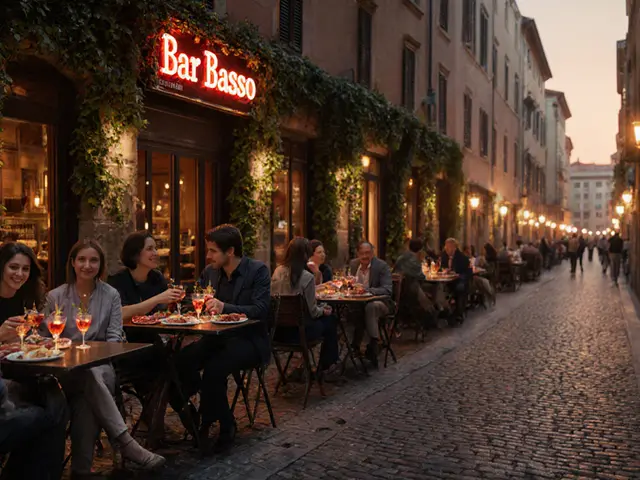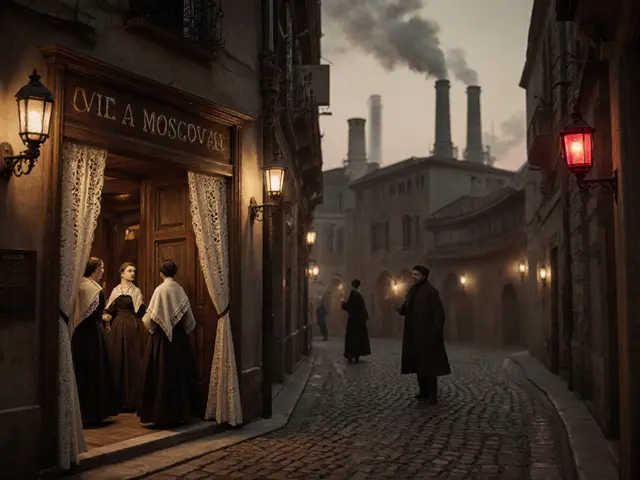Paint the Town Red: The Best Nightlife in Milan Right Now

When the sun sets in Milan, the city doesn’t shut down-it switches modes. The same streets where you saw designer boutiques and art galleries by day become pulsing corridors of music, laughter, and neon. This isn’t just a party scene. It’s a cultural ritual. Locals don’t go out to drink; they go out to connect, to see and be seen, to turn the night into something unforgettable. If you’re looking for the real Milan after dark, skip the tourist traps. Here’s where the city actually comes alive.
Brera: Where the Night Starts with Aperitivo
Brera is the heartbeat of Milan’s evening rhythm. Narrow cobblestone lanes, ivy-covered buildings, and art studios give it a bohemian charm. But by 7 p.m., the real magic begins: the aperitivo. This isn’t just a pre-dinner drink. It’s a full-blown ritual. At Bar Basso, you’ll find the original Negroni Sbagliato-bitter, sweet, fizzy, and served with a spread of cold cuts, cheeses, and warm focaccia. No extra charge. Just order a drink, and the food comes with it. Locals know: if you’re not eating while you sip, you’re doing it wrong.
By 9 p.m., the crowd thins out slightly, and the real nightlife crowd moves in. La Scala isn’t the opera house-it’s a tiny, unmarked bar behind a curtain in a courtyard. No sign. No website. Just a door that opens if you know the code. Inside, jazz plays softly, cocktails are made with house-infused spirits, and the bartenders remember your name. It’s the kind of place you stumble into by accident and spend the next three nights trying to find again.
Navigli: Canals, Cocktails, and Open-Air Vibes
If Brera is the intellectual’s night out, Navigli is the city’s playground. The canals that once carried goods now float with boats turned into floating bars. Walk along the water after 8 p.m., and you’ll see people perched on wooden stools, sipping spritzes under string lights. The vibe is casual, loud, and full of life.
Bar Luce-a spot inspired by Wes Anderson’s aesthetic-is a must. Think pastel walls, retro furniture, and a menu that changes weekly. Their Aperol Spritz comes with a side of live acoustic guitar. Don’t miss Il Gatto Nero, a hidden gem tucked under a bridge. It’s a tiny wine bar with 40+ bottles by the glass, all under €8. The owner, Marco, will recommend a wine based on your mood. No list. Just trust him.
On weekends, the stretch between Via Tortona and Via Giulia turns into a street party. Pop-up DJs, food trucks serving truffle arancini, and people dancing on the cobblestones. No tickets. No cover. Just good music and a city that refuses to sleep.
Porta Romana: The Underground Scene
If you think Milan nightlife is all polished and expensive, you haven’t been to Porta Romana. This neighborhood is where the city’s underground culture thrives. No velvet ropes. No dress codes. Just raw energy.
Teatro del Sale is a former theater turned into a multi-room club. One night, it’s a punk rock show. The next, a techno set with a live painter projecting visuals on the walls. The crowd? Artists, students, designers, and expats who’ve lived here long enough to know the real spots. The cover? Usually €10 or less. The drinks? Craft beer for €5, local gin for €7.
Down the street, Bar Pasticceria Cova stays open until 3 a.m. and serves espresso martinis with a side of cannoli. It’s not fancy. But it’s where you’ll find Milanese people who’ve been coming here for 20 years. No Instagram filters needed.

Corso Como: The Luxury That Doesn’t Try Too Hard
Corso Como is where Milan’s elite unwind without the flash. The famous Corso Como 10 isn’t just a club-it’s a cultural hub. A design store by day, a members-only lounge by night. The crowd here is quiet, confident, and effortlessly stylish. You won’t see neon signs or bouncers. Just a single black door. If you’re not on the list, you can still get in if you look like you belong. And if you do? You’ll get a table with a view of the courtyard, where a DJ spins rare vinyl and the cocktails are made with ingredients you’ve never heard of.
For something more intimate, try Il Salumiere, a wine bar hidden behind a deli counter. The owner, Alessia, has curated a list of 200 Italian wines-mostly small-batch, organic, and from regions you’ve never visited. She’ll pour you a glass of something from Sicily or Friuli, then tell you the story behind it. No tasting notes. Just truth.
Where to Go When You Want to Dance
Milan’s club scene is split between the classic and the cutting-edge. If you’re after a big-name DJ, head to Alcatraz. It’s been around since the 90s and still draws international acts. The sound system is legendary. The crowd? Young, international, and here for the music, not the photo ops.
For something more experimental, La Scala Club (not to be confused with the bar) is a warehouse space in the outskirts. No signage. You get the address via WhatsApp the day before. Inside, it’s dark, sweaty, and full of people who dance like no one’s watching. The music? Industrial techno, ambient house, or live noise sets. It’s not for everyone. But if you’ve ever wanted to feel like you’re in a secret rave in the heart of Europe, this is it.
And then there’s Magazzini Generali-a former warehouse turned into a multi-level club with rooftop views of the city. The music changes every night: funk, disco, hip-hop, or deep house. The drinks? Overpriced, but the view isn’t. Go at midnight, climb to the top floor, and watch the lights of Milan blink below you. That’s the moment you’ll remember.

When to Go and What to Wear
Milan doesn’t start late. Most bars fill up between 9 and 11 p.m. Clubs don’t really heat up until after midnight. If you show up at 10 p.m., you’ll be one of the first. If you show up at 1 a.m., you’ll be fighting for space.
As for what to wear: Milanese people dress well, but not for show. Think clean lines, dark tones, quality fabrics. A well-fitted jacket, dark jeans, and boots will get you everywhere. Sneakers? Only if they’re designer. Shorts and tank tops? You’ll get stared at. This isn’t Ibiza. It’s Milan. The standard is quiet luxury.
What to Avoid
Don’t go to the spots near the Duomo that advertise “Happy Hour” with flashing signs. Those are for tourists who want to check a box. The drinks are overpriced, the music is generic, and the vibe is dead.
Avoid clubs that require you to book a table in advance unless you’re with a group of six or more. Most of the best spots don’t take reservations. Walk in. Be cool. You’ll be fine.
And never, ever ask for a “Bacardi and Coke.” You’ll get a look that says you don’t belong. Stick to Italian classics: Aperol Spritz, Negroni, Prosecco, or a simple white wine. They know how to make them here.
Final Tip: The Midnight Walk
One of the best ways to experience Milan’s nightlife? Take a walk after midnight. Start in Brera, wander through Navigli, then head toward Porta Romana. You’ll pass couples laughing on benches, street musicians playing old Italian ballads, and groups of friends sharing a bottle of wine on the sidewalk. No one is rushing. No one is taking photos. They’re just living.
This is Milan after dark. Not a checklist. Not a photo op. A feeling. And if you’re lucky, you’ll leave with more than a memory-you’ll leave with a reason to come back.
What’s the best time to start a night out in Milan?
Most Milanese start their evening around 9 p.m. with an aperitivo. Bars fill up between 9 and 11 p.m. Clubs don’t really get busy until after midnight, and the real energy hits around 1 a.m. Don’t rush-Milan’s rhythm is slow, then explosive.
Do I need to book tables at Milan clubs?
Only at the biggest venues like Alcatraz or Magazzini Generali on weekends. Most underground spots, bars, and hidden clubs don’t take reservations. Walk in. Dress well. Be polite. You’ll get in. Booking a table is usually for groups of six or more, and it often comes with a minimum spend.
Is Milan nightlife expensive?
It can be, but it doesn’t have to be. Aperitivo in Brera costs €12-15 and includes a full buffet. Craft beer in Porta Romana is €5. A cocktail at a hidden bar? €10-12. Clubs charge €10-15 cover, often with a free drink included. Luxury spots like Corso Como 10 are pricier, but you can enjoy the city’s best nightlife without spending more than €30-40 total.
What’s the dress code for Milan nightlife?
Think quiet luxury. Dark jeans, a tailored jacket, leather boots, and minimal accessories. No hoodies, no flip-flops, no sports jerseys. Sneakers are okay if they’re clean and stylish. Milanese people dress to feel good, not to impress. You’ll stand out if you look like you’re trying too hard.
Are there any safe areas for solo travelers at night?
Yes. Brera, Navigli, and Corso Como are very safe and well-lit. Porta Romana is also fine, especially around the main bars. Avoid walking alone through empty industrial zones after 2 a.m. Stick to the main streets. Milan is one of the safest major European cities at night, but always trust your gut.
What’s the best drink to order in Milan?
Start with an Aperol Spritz for the aperitivo. Then try a Negroni Sbagliato, a classic Italian cocktail made with Prosecco instead of gin. If you’re in a wine bar, ask for something from Friuli or Sicily. Avoid American-style cocktails like mojitos or margaritas-they’re not local, and they’re usually poorly made here. Stick to what the Italians know best.



